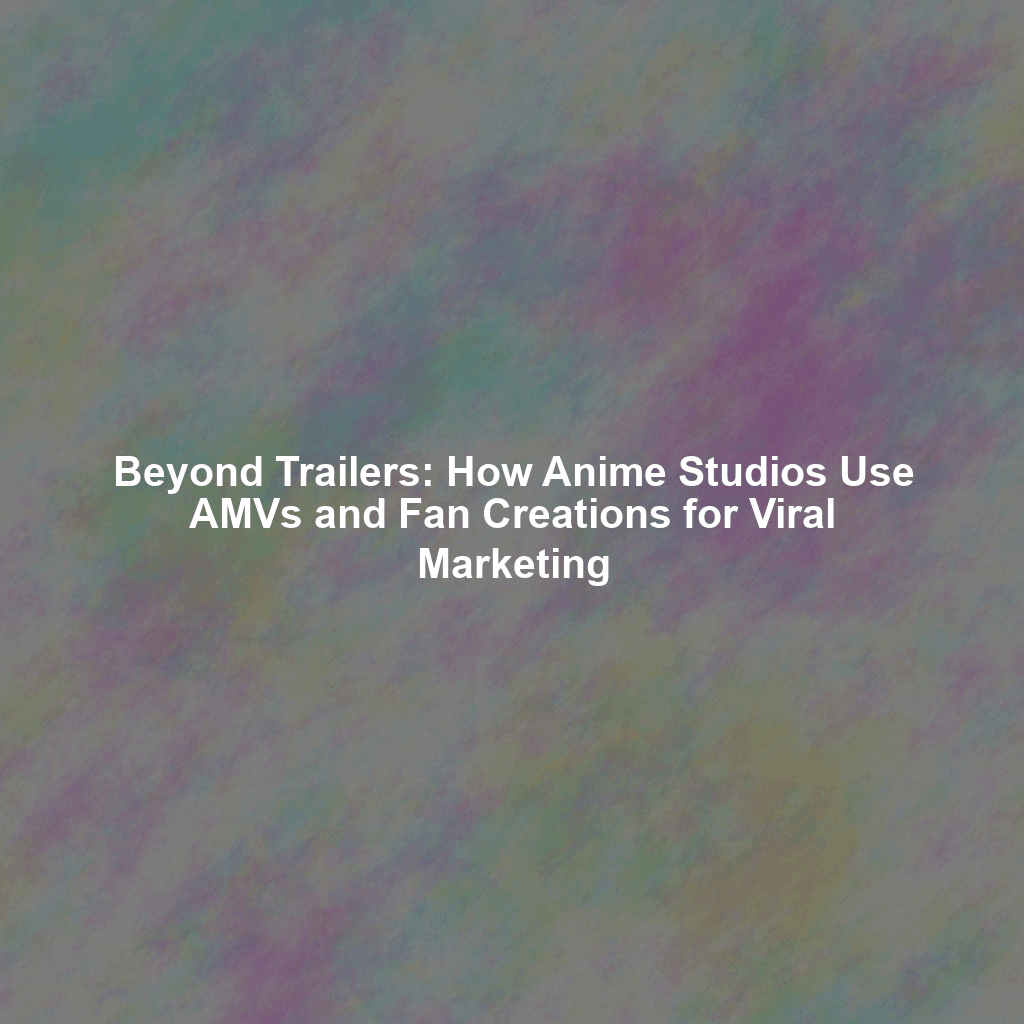Strategic Collaborations and Exciting Crossovers: The New Frontier of Anime Marketing and Fan Engagement
In the dynamic and ever-expanding global landscape of the anime industry, simply offering a compelling narrative or stunning animation is no longer sufficient to guarantee widespread success and enduring relevance. To truly break through the noise, expand their audience footprint, and cultivate deep, lasting fan loyalty, anime studios are increasingly turning to a powerful, modern tool: strategic collaborations and exciting crossovers. These ingenious partnerships, ranging from deeply integrated anime tie-ins with global video game phenomena like the highly anticipated Genshin Impact collaborations, to unexpected fashion brand alliances (think Uniqlo’s hugely successful anime collections), and even real-world location partnerships that cleverly leverage anime tourism (as vibrantly seen with towns like Hirosaki and its charming influence on “Flying Witch”), offer a direct, high-impact route to untapped demographics and create uniquely memorable fan experiences that transcend traditional media consumption. This comprehensive article delves deep into the multifaceted benefits of these anime collaborations, showcases an array of successful, market-leading examples, and meticulously outlines the best practices for forging truly mutually beneficial and sustainable partnerships in this exciting new era of entertainment.
CRITICAL STRATEGIC SHIFT:
Modern anime success hinges on transcending the screen. Collaborations are not just marketing stunts; they are strategic investments in brand ecosystem expansion and diversified revenue streams.
The Synergistic Power of Partnerships: Why Anime Embraces Collaborations
In today’s hyper-competitive global entertainment market, where attention spans are fragmented and content consumption is diverse, strategic collaborations offer a significant, often indispensable, advantage. They provide direct access to vast, new audiences and inject fresh, innovative perspectives into established franchises, keeping them vibrant and relevant. This symbiotic relationship creates value far beyond what individual entities could achieve alone.
- Expanding the Tentacles of Reach and Awareness: Partnering with another popular anime series, a globally recognized video game, or a relevant, high-visibility brand instantly exposes the collaborating anime to the partner’s colossal existing fanbase. For instance, the strategic appearance of a character from a relatively niche anime series within a mainstream, globally popular mobile game (like a speculated *Genshin Impact* crossover) achieves instant, massive exposure that organic marketing efforts alone could take years to build. This cross-pollination generates invaluable buzz and brand recognition.
- Strategically Tapping into Untapped Demographics: Collaborations are a precision tool for audience diversification. A typically male-skewing shonen battle anime might strategically partner with a contemporary fashion brand widely popular among young women to significantly broaden its demographic appeal. Similarly, a heartwarming slice-of-life anime could collaborate with a major food company or a family-oriented theme park to attract broader family audiences. Careful and data-driven partner selection allows for highly targeted marketing efforts, breaking down traditional audience silos.
- Crafting Uniquely Memorable and Engaging Experiences: Beyond mere advertising, collaborations enable the creation of truly immersive and interactive brand engagement. Think limited-edition, highly sought-after merchandise drops, exquisitely themed cafes (like the ever-popular Crunchyroll Cafe experiences), or unexpected crossover episodes and interactive digital events. These initiatives offer fans multi-sensory experiences that go far beyond traditional anime consumption, fostering deeper emotional connections and turning casual viewers into passionate advocates.
- Driving New Revenue Streams: Beyond brand awareness, collaborations are significant revenue generators. This includes direct sales from co-branded merchandise, licensing fees, increased viewership translating to ad revenue or subscriptions, and even tourism-related income from location-based activations.
When Two Become One (Successfully!): A Look at Winning Anime Collaboration Strategies That Hit the Mark
The anime industry, with its rich tapestry of characters and worlds, provides an abundance of compelling examples of highly successful collaborations that have not only achieved marketing objectives but also delighted fans and generated substantial financial returns. These case studies highlight the diverse potential of strategic partnerships:
- Anime x Anime Crossovers: When Beloved Worlds Intriguingly Collide:
Perhaps the most direct form of collaboration, these crossovers leverage the existing fanbases of multiple series. Shows like Isekai Quartet brilliantly bring together beloved characters from different isekai anime (e.g., *Overlord*, *Konosuba*, *Re:Zero*) into a shared, comedic universe. This generates massive viewership through the sheer novelty and fan service of seeing these iconic interactions, reigniting interest in the source material for each participating series.
- Anime x Video Games: A Match Made in Otaku Heaven:
The synergy between anime and video games is undeniable, as both mediums thrive on rich storytelling, character development, and immersive worlds. This often results in highly anticipated and immensely popular collaborations.
- Genshin Impact x Demon Slayer/Attack on Titan (Speculated Dream Collabs): While these specific crossovers remain fan speculation, the sheer volume of anticipation for potential collaborations between a globally dominant game like *Genshin Impact* and powerhouse anime franchises like *Demon Slayer* or *Attack on Titan* underscores the immense marketing and financial potential. Such events would bring millions of new players to the game and gamers to the anime.
- Fate/Grand Order x Multiple Anime: A Mobile Gaming Collab Masterclass: The highly successful mobile game Fate/Grand Order frequently engages in tactical collaborations with various other anime series (e.g., *Kara no Kyoukai*, *Tsukihime*, *The Garden of Sinners*). These events introduce new characters, limited-time storylines, and unique gameplay mechanics, driving renewed engagement, in-app purchases, and sustained interest in both the game and the collaborating anime.
- Iconic Anime Characters in Fighting Games: A Star-Studded Digital Arena: The inclusion of instantly recognizable anime characters, such as Goku from *Dragon Ball* in fighting games like Jump Force or *Dragon Ball FighterZ*, leverages established global popularity to attract legions of new players who might not typically engage with the fighting game genre. This is a powerful brand extension that monetizes character IP.
- Anime x Brand Collaborations: Merchandising Mania and Beyond the Expected:
These partnerships extend anime IP into diverse consumer markets, ranging from everyday goods to luxury items.
- Pokemon x McDonald’s: The Enduring Power of Happy Meal Magic: The timeless phenomenon of Pokemon Happy Meal toys continues to drive massive traffic to McDonald’s, acting as a powerful cross-generational marketing tool that introduces the franchise to new, younger audiences while delighting existing fans.
- Attack on Titan x Real Escape Game: Immersive Real-World Action: Companies like Real Escape Game have brilliantly created numerous immersive *Attack on Titan*-themed escape room events globally. These experiences allow fans to physically step into the world of the anime, engaging with its narrative and characters in a tangible, high-stakes way, generating unique memories and strong word-of-mouth.
- Evangelion x Various Brands: Aesthetic Synergy and Unexpected Partnerships: The iconic Evangelion franchise has become a master of diverse brand collaborations, extending its distinctive aesthetic beyond typical anime merchandise. Partnerships have ranged from high-fashion brands to car manufacturers (like Yamaha scooters featuring Evangelion livery) and even convenience stores. These unexpected alliances speak to the unique brand identity and appeal to a broader, more sophisticated consumer base.
- Anime x Location-Based Marketing: Creating Immersive Fan Pilgrimages:
This innovative strategy leverages real-world locations that inspired or are depicted in anime, creating a unique form of tourism. Towns that served as muses for popular anime, such as Hida City, which heavily influenced “Your Name,” transform into pilgrimage sites for fans. These locations often develop themed events, local merchandise, and guided tours, creating immersive fan experiences that generate significant local economic impact and reinforce the anime’s cultural footprint.
Forging Synergistic Success: Best Practices for Mutually Beneficial Anime Partnerships That Last
While the potential rewards of anime collaborations are immense, achieving truly synergistic and sustainable success requires meticulous strategic planning and execution. A haphazard approach can lead to diluted brand image or even negative fan reactions. Here are the key best practices for forging mutually beneficial anime partnerships:
- Identify and Prioritize Shared Core Values and Overlapping Target Audiences: The foundation of any successful collaboration is genuine alignment. Partners must share complementary brand images, target demographics, and perhaps even core values. For example, a heartwarming, family-friendly anime should partner with a family-oriented brand or product. This ensures the collaboration feels organic and authentic to both fanbases, preventing brand dissonance.
- Clearly Define Roles, Responsibilities, and Expectations from the Outset: Ambiguity is the enemy of collaboration. A comprehensive, legally sound agreement outlining the precise scope of the partnership, budget allocations, timelines, intellectual property usage, and expected deliverables is absolutely crucial. This mutual understanding minimizes disputes and ensures smooth execution.
- Prioritize Authenticity and Genuine Fan Engagement Above All Else: Modern audiences, particularly passionate anime fans, can discern inauthentic collaborations from genuine ones. The partnership must feel natural and offer true value or unique experiences. Prioritize fan interaction through social media contests, interactive Q&A sessions with creators, behind-the-scenes content, or exclusive access. Avoid collaborations that appear to be purely commercial cash-grabs.
- Meticulously Track and Thoroughly Analyze the Results of the Collaboration: Data-driven decision-making is paramount. Implement robust tracking mechanisms to monitor key performance indicators (KPIs) such as website traffic spikes, social media engagement rates (mentions, shares, sentiment), merchandise sales figures, viewership increases for the anime, and any relevant cross-promotional lift. This analysis helps determine the true effectiveness and ROI of the partnership and informs future strategies.
- Maintain an Open Mind and Embrace Creative and Innovative Ideas: The most memorable and impactful collaborations often stem from pushing creative boundaries and thinking outside the box. Don’t limit partnerships to obvious merchandise; explore unique experiential activations, digital integrations, or unexpected product lines. Encourage creative brainstorming to discover novel ways to engage audiences.
BEST PRACTICE SUMMARY:
Authenticity + Clear Planning + Data-Driven Analysis + Creative Vision = Collaborative Success. Always prioritize the fan experience and mutual brand benefit.
Conclusion: The Collaborative Future of Anime Marketing and Beyond
Strategic collaborations and innovative crossovers are no longer a peripheral marketing tactic; they are now an absolutely vital, core component of successful anime marketing. They offer an unparalleled means of expanding reach into diverse demographics, cultivating deep, resonant fan engagement, and creating new, sustainable revenue streams. By carefully selecting partners with shared values, meticulously defining the terms of engagement, unequivocally prioritizing authenticity, and fostering genuine, immersive fan experiences, anime studios can achieve remarkable, measurable results that go far beyond traditional viewership metrics.
As the global anime industry continues its meteoric evolution and digital consumption habits shift, these dynamic partnerships will play an even more critical, foundational role in its continued success, driving both cultural impact and significant business growth. The future of anime is not just about creating captivating stories; it’s about strategically connecting those stories to broader cultural touchpoints through intelligent collaboration.
 Skip to content
Skip to content

